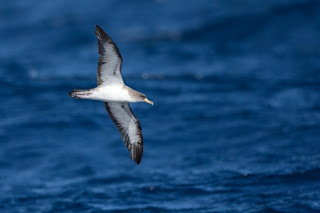We spent most of the day with a number of birds in view. The Black-capped Petrels were amazing. They flew circles around the shearwaters as usual and they seemed to mock the trio of young Herring Gulls that had found us and were steadily picking at scraps of chum in our wake. The Black-caps were beginning to look sharp, having gotten past the rattiness of their summer molt. I was a bit surprised that we didn't see a few jaegers out there with all the shearwaters, but one Pomarine was all we found. Wilson's Storm-Petrels were remarkably scarce and it took awhile to chum one in close to the boat. There were also a few phalaropes seen fleetingly. The combination of big seas and widely scattered Sargasso weed is not a good recipe for seeing phalaropes well. Likewise such days are not usually so good for terns and we saw no Bridled or Sooty Terns. There was plenty of Sargasso weed but I saw little flotsam and when that's missing, so are the Bridleds.
After such a good showing last month, I had high hopes for seeing a Trindade Petrel, but it was not to be on Sunday. Likewise, no Sabine's Gull. That is mostly a September bird here, but we certainly don't see them on all of the trips. It was a day without a stand-out bird, or at least one we could be sure of. During the morning, just past the shelf break, our leader, Nick Bonomo, spotted a slim looking Calonectris shearwater, which he called in. There were a lot of Cory's Shearwaters buzzing around in the glare and I did not see it. Nick snapped a couple of photos of the bird that looked notably slimmer and slightly smaller than the numerous Cory's. These are characters of "Scopoli's" Shearwater, but the underwing of the bird in question was wrong for that - it had dark looking under primaries. Looking at his photo the bird has rather narrow wings in comparison to a nearby (Atlantic) Cory's (C.d. borealis). The bill also looks both thinner and shorter. Cape Verde Shearwater? Maybe. If so, it just goes to show that it might be worth spending some more time in the Gulf Stream during the late summer and fall. Cape Verde Shearwater is a stealth vagrant, the sort of bird that can easily slip by in less than calm conditions. The only one we ever nailed down was a bird we saw on August 15, 2004. I spotted that one on the water with a few Cory's and we got to study it closely before it flew off at close range. We've been scouring flock after flock of Cory's Shearwaters for nine years since. It's always disappointing when a potential mega-rarity gets by, but when you think about it, how many Cory's Shearwaters do you see closely and how many are specks on the horizon? Likewise with Black-capped Petrels. Fortunately Black-capped Petrels are identifiable at nearly infinite distance in good light. What I'm trying to say is the odds are against you when it comes to getting a good, close, long look at an exceptionally rare seabird, especially on a breezy day. But just knowing it might be out there drives us to keep going.
-Brian Patteson
The trip list is on our website, thank you to everyone who stood by to come on Sunday's trip! And thank you to Nick Bonomo for helping us out as a leader and contributing some of his photos. Thanks to participant Doug Koch for allowing us to use some of his photos as well!
Two images of dark-faced Black-capped Petrels (photos by Nick Bonomo)
Only a couple distinctly white-faced individuals were seen (photo by Nick Bonomo)
Atlantic Cory's Shearwater C. d. borealis (photo Nick Bonomo)
Nominate Cory's (Scopoli's) Shearwater C. d. diomedea (photo Nick Bonomo)
Black-capped Petrels (photos by Doug Koch)
Cory's Shearwaters (photos by Doug Koch)
Nominate Cory's (Scopoli's) Shearwaters (photos by Doug Koch)
Audubon's Shearwaters (photos by Doug Koch)




















No comments:
Post a Comment